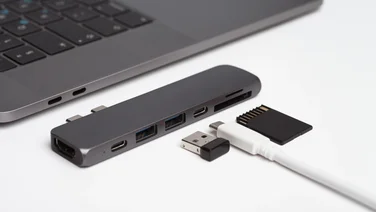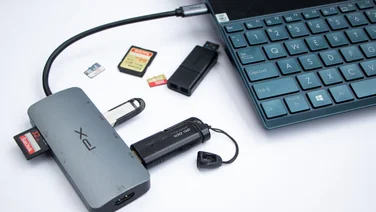To help us provide you with free impartial advice, we may earn a commission if you buy through links on our site. Learn more

- Supreme CPU and GPU performance
- Abundant external connectivity
- More affordable than competitors
- Might be overshadowed by new Ryzen 3000 builds
The Inferno R1 isn’t just another mid-tower gaming PC. Thanks to our AMD Ryzen 3000 review kit being delayed, it gives us our first look at one of the new third-generation CPUs – the Ryzen 5 3600X – as well as the GeForce RTX 2060 Super graphics card, a souped-up version of Nvidia’s excellent RTX 2060. It’s almost as up to date a PC as it’s possible to get – but even so, it’s not all that expensive.
That’s because, at least ostensibly, these two key components are mid-range parts. The Ryzen 5 3600X, for instance, is a replacement for the sub-£200 Ryzen 5 2600X from last year. It’s still a hexa-core, 12-thread processor and uses the same AM4 socket, but clock speeds have risen to a 3.8GHz base speed and a 4.4GHz boost speed.
PC Specialist Inferno R1 review: Features and Performance

The result is noticeably improved multicore strength and, even more tantalisingly, vastly superior single-core speed, the latter being an area in which previous Ryzen chips, across the entire range, have always struggled with compared to Intel chips. The Inferno R1 helps out the silicon with 16GB of DDR4 RAM, forming the brain of a system that scored 186 in our 4K benchmark’s image test, 255 in the video test, 302 in the multitasking test and 267 overall.
These are all great scores, but particular attention must be paid to the image test, which focuses on single-core performance. Here, the Inferno R1 scored even higher than the PC Specialist Vortex S2 and its Intel Core i7-9700F, while also coming close to its overall score of 278. That’s a very convincing performance by the Ryzen 5 3600X, showing all of the Ryzen family’s characteristic multithreading capability while demonstrating that even its mid-range chips can beat Intel’s higher-end CPUs on the latter’s home turf of single-core power.
In this particular system, the Ryzen 5 3600X comes running at stock speeds, but it’s unlocked for overclocking. The inclusion of the all-in-one watercooler helps make this a viable possibility, although when it comes to home use there’s not much that the CPU won’t be able to handle with stock speeds. This is a PC you could quite happily use for editing photos and videos, or streaming while playing games.
PC Specialist Inferno R1 review: Gaming performance

Speaking of which, that newfound single-core proficiency can be a big help in certain games. Dirt Showdown is a perfect example: it’s heavily CPU-dependent, which can cause bottlenecking on more powerful GPUs and prevent them from reaching their full performance potential. There’s not a whiff of this happening on the Inferno R1: with Ultra quality and 4x MSAA, it produced 190fps at 1,920×1,080, 164fps at 2,560×1,440 and 94fps at 3,840×2,160. If you don’t pair a PC such as this with a 144Hz monitor (or higher), you’re missing out.
Of course, credit also goes to the RTX 2060 Super. On paper, it’s a surprisingly radical overhaul of the standard RTX 2060: the CUDA core processor count goes up from 1,920 to 2,176, and the amount of GDDR6 memory rises from 6GB to 8GB, the same specification as most of Nvidia’s high-end GPUs. As there’s also an RTX 2070 Super, we suspect this was to bridge the gap between the RTX 2060 and last year’s RTX 2070.
Admittedly, the actual effect of these changes is minor: most of our benchmarks saw improvements of 10fps or lower compared to what the RTX 2060 Founders Edition managed in our test PC. Then again, that doesn’t make it any less of a wonderfully capable gaming system for the price. Even in Metro: Last Light Redux, which heavily punishes GPU weaknesses, the Inferno R1 had few problems getting to 89fps at 1,920×1,080 and 53fps at 2,560×1,440. Using the same combination of maxed-out settings was a little too much to ask at 3,840×2,160, with the Inferno R1 dropping to 26fps, although turning off SSAA was enough for it to shoot right back up to 48fps.
Interestingly, all these results are either roughly equal to or clearly ahead of those of the Chillblast Fusion Ryzen 7 RTX 2070. That PC is one of the best we’ve tested this year, but even though it’s £160 more expensive and has – as the name implies – an RTX 2070, the Inferno R1 is just as good for gaming. Both systems received the same SteamVR Performance Test score as well, with 11 out of 11.
READ NEXT: Best gaming mouse
PC Specialist Inferno R1 review: Specifications
We’re planning a standalone review to see whether the RTX 2060 Super will be a worthwhile upgrade for home PC builders, but for now we’re happy to see it doing so well in a pre-built system. Even if it is only mildly more powerful than a standard RTX 2060, a handful of extra frames can make a visible difference at 1440p and 4K, and if it’s pushing the Inferno R1 to undercut rival PCs without sacrificing speed, then we can’t complain too much.
To keep from breaking through the £1,200 mark, PC Specialist has fitted an X470 motherboard, rather than a more recent model that uses the X570 chipset launched alongside the Ryzen 3000 processors. This is fine by us, as the Ryzen 5 3600X is backwards-compatible with the older chipset, and this specific motherboard – Asus’s TUF X470-Plus Gaming – is one of very few last-gen motherboards to share the X570’s major feature of PCI-E 4.0 support.
That means the Inferno R1 can be equipped with a PCI-E 4.0 M.2 SSD, which are potentially capable of read and write speeds up to 5,000MB/s. To start with, however, you’ll have to make do with a 256GB PCI-E 3.0 SSD, along with a 2TB hard disk for more general storage duties.
That’s a shame, though an understandable one: PCI-E 4.0 SSDs can currently cost anywhere between £30 and £150 more than an equivalent-capacity 3.0 drive, and so far seem to only come in larger capacities like 1TB and 2TB, so they’re not as economically feasible for a £1,199 system unless big cuts are made elsewhere. For now, it’s fine to think of 4.0 support as futureproofing; besides, the included SSD is hardly slow. Using the AS SSD benchmark, we measured very quick sequential read and write speeds of 2,315MB/s and 1,276MB/s respectively.
PC Specialist Inferno R1 review: Connectivity

Should you wish to add an upgraded SSD in the future, the motherboard has a conveniently vacant M.2 slot in addition to the one already occupied by the 256GB SSD. Internal upgradability is good in general: there are two empty PCI-E x1 slots and one empty PCI-E x16 slot, with two RAM slots and five SATA ports also spare. The only aspect that’s a bit sparse is support for physically larger storage drives: there’s only one dedicated 3.5in tray and two 2.5in mounts, although the former’s cage can additionally hold either one 3.5in drive or one 2.5in drive on top.
External connectivity should more than suffice. The rear I/O panel looks quite basic at first glance, with no premium audio connectors and an older PS/2 socket, but two of the six full-size USB ports are of the fast USB3.1 standard. A single USB Type-C port also improves the Inferno R1’s cabled flexibility, while two USB2 and two USB3 ports handle peripherals. Networking offers a choice of wired Ethernet or 802.11n Wi-Fi, granted via a PCI-E x1 card, and the graphics card’s single HDMI and three DisplayPort outputs will suit both single- and multi-monitor configurations.
READ NEXT: Best budget gaming monitor
PC Specialist Inferno R1 review: Verdict
There’s lots about the Inferno R1 to be pleased about, then, but it’s the CPU and GPU that will draw the biggest smiles. Both punch above their weight in pure performance, and their middling prices help keep the PC as a whole more affordable than comparably powerful systems.
The Inferno R1 is likely to get some tough competition as other PC builders bring out their own Ryzen 3000 systems, so it’s probably worth waiting before you buy. That said, you could take delivery tomorrow and would still have a great PC on your hands.






